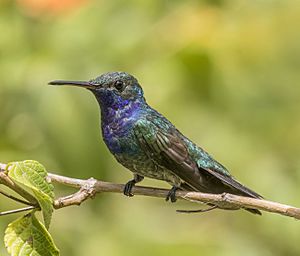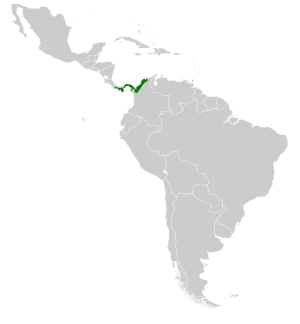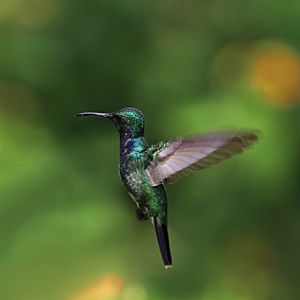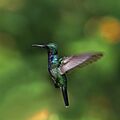Sapphire-throated hummingbird facts for kids
Quick facts for kids Sapphire-throated hummingbird |
|
|---|---|
 |
|
| Male, Panama | |
| Conservation status | |
| Scientific classification | |
| Genus: |
Chrysuronia
|
| Species: |
coeruleogularis
|
 |
|
| Range of C. coeruleogularis | |
| Synonyms | |
|
|
The sapphire-throated hummingbird (Chrysuronia coeruleogularis) is a beautiful bird. It has shiny metallic-green feathers. You can find it in Panama, Colombia, and recently in Costa Rica. This hummingbird is divided into three slightly different types, called subspecies. These are Chrysuronia coeruleogularis coeruleogularis, Chrysuronia coeruleogularis coelina, and Chrysuronia coeruleogularis conifis.
This hummingbird is about 9 centimeters (3.5 inches) long. It has a special forked tail. This tail helps tell it apart from other hummingbirds that look similar. The male bird is mostly metallic green. It has a bright violet-blue throat and a dark tail. The female has white feathers on her belly. She also has green spots on the sides of her chest.
The sapphire-throated hummingbird lives in a large area. It can also adapt well to changes in its home. Because of this, it is listed as a species of least concern by the IUCN Red List. This means it is not currently in danger. It likes to live in mangroves, scrub areas, and light forests. But it can live in other places if it needs to.
Contents
About This Hummingbird
The sapphire-throated hummingbird belongs to a group of birds called Apodiformes. This group includes all hummingbirds, swifts, and treeswifts. They are part of the Trochilidae family. Hummingbirds are known for being very small. They also have a very fast metabolism and flap their wings incredibly quickly.
This species was first described in 1851. Later, scientists found two more subspecies. These were different in where they lived and their colors. The first type found is called Chrysuronia coeruleogularis coeruleogularis. In 1856, the second type, Chrysuronia coeruleogularis coelina, was found further north. The third type, Chrysuronia coeruleogularis conifis, was found in 1932 further east.
This hummingbird used to be in a different group called Lepidopyga. But a study in 2014 showed that Lepidopyga was not a single group. So, the sapphire-throated hummingbird was moved to the Chrysuronia group.
What It Looks Like
The sapphire-throated hummingbird has shiny metallic-green plumage (feathers). Its tail and wings are a darker color. Male birds have a wide, sparkling blue patch on their throat. Females have a white patch on their throat. Females also have clear green spots on the sides of their chest. The tail has a deep notch and black tips.
The first type, Chrysuronia coeruleogularis coeruleogularis, has a darker throat patch. The Chrysuronia coeruleogularis conifis type has a more turquoise throat. The Chrysuronia coeruleogularis coelina type has a lighter blue throat. These small birds are about 8.5 to 9.5 centimeters (3.3 to 3.7 inches) long. They weigh about 4 to 4.5 grams (0.14 to 0.16 ounces). Males have a straight, short bill. The upper part of the bill (maxilla) is black. The lower part (mandible) is pinkish with a black tip.
People sometimes confuse the sapphire-throated hummingbird with other birds in its group. These include the sapphire-bellied hummingbird (Chrysuronia lilliae) and the shining-green hummingbird (Chrysuronia goudoti). The male sapphire-bellied hummingbird has a darker, shiny blue throat. This blue color covers its whole belly, except for a white patch under its tail. The shining-green hummingbird has very little to no blue feathers compared to the other two.
Where It Lives
Distribution
The sapphire-throated hummingbird lives in a large area. This area is about 88,900 square kilometers (34,300 square miles). We don't know the exact number of birds, but they are found in scattered groups. You can find them across Panama, Colombia, and recently Costa Rica.
The first type, Chrysuronia coeruleogularis coeruleogularis, lives in western Panama. This is from Chiriquí to the Canal Zone. The Chrysuronia coeruleogularis confinis type is found on the Caribbean side of eastern Panama and northwest Colombia. The Chrysuronia coeruleogularis coelina type lives in northern Colombia. This includes north Chocó through Ciénaga Grande de Santa Marta.
In 2008, a male sapphire-throated hummingbird was seen in Costa Rica. It was about 35 kilometers (22 miles) north of the Panama border. This suggests that these hummingbirds are slowly moving north. They are also creating new homes.
Habitat
The sapphire-throated hummingbird usually lives in coastal forests. They like secondary forests, which are forests that have grown back. They also like scrubby open areas. Less often, they live in mangrove patches. They prefer light forests and forest edges over very dense forests. These hummingbirds have been seen using changed habitats. For example, they live in protected areas like the Tayrona National Natural Park in Colombia. They can live at heights of up to 100 meters (328 feet) above sea level.
How It Behaves
This hummingbird lives in Central and South America. So, it does not make long migrations like some northern hummingbirds. An example is the Ruby-throated hummingbird. However, they might move to different altitudes if their habitat changes. They live alone and do not travel in flocks.
When flying, hummingbirds have a very high metabolism. They need to eat more than their own weight in nectar every day. This prevents them from starving. Unlike most birds, hummingbirds flap their wings upwards. They do this by turning their wings. This way of flying is similar to how insects fly.
Reproduction
Courtship
The sapphire-throated hummingbird is polygamous. This means one male mates with many females. They live alone until it's time to reproduce. To get the female's attention, the male performs a special courtship display. He flies in a U-shape pattern for her. After mating, the male leaves the female right away. Males only mate. They do not help choose the nest spot, build the nest, or raise the young.
Nesting and Incubation
The female hummingbird chooses a place for her nest. This is usually in a shrub, bush, or tree. She places the nest on a low, thin, forked branch. She builds the nest in a cup shape. She weaves plant fibers together and covers the nest with moss. This helps to camouflage it. To make the nest strong and flexible, the female adds soft plant fibers, animal hair, and down feather. She secures it with spider webs and other sticky materials. The nest is small and deep.
Eggs and Young
Because of its small size, the sapphire-throated hummingbird usually lays only two eggs. The eggs hatch after 15 to 16 days. The young birds are born without feathers. They cannot fly or see yet. The time it takes for them to leave the nest (fledging period) is 19 to 22 days. Since the males do not help, the females protect and feed the young. They feed them regurgitated food. The female uses her long bill to push insects directly into the chicks' throats.
What It Eats
The sapphire-throated hummingbird mainly eats nectar and insects. It usually feeds alone. During times when many flowers are blooming, it might build small "home structures" around flowering trees. This helps it protect its food. The rest of the year, it mostly eats from low-growing flowers.
Nectar
This hummingbird typically feeds on nectar from brightly colored flowers. These flowers grow on trees and shrubs. To fuel their high metabolism, they prefer flowers with lots of sugar. These include flowers from the Fabaceae, Rubiaceae, and Myrtaceae families.
They feed from tube-shaped flowers. They extend their long tongue to get the nectar. At the same time, they hover or perch on the flower or branch. While feeding, hummingbirds often get covered in pollen. They then help pollinate plants. This is a symbiotic relationship between the plant and the bird.
In areas where people live, sapphire-throated hummingbirds might also get nectar from hummingbird feeders.
Insects
Nectar is the main food for the sapphire-throated hummingbird. But it does not provide enough protein. This is especially true during breeding season and when the young are growing. So, the hummingbird also eats arthropods, like flies and spiders.
Sounds It Makes
Hummingbirds are often known for the buzzing sound their fast wings make. Like most birds, the sapphire-throated hummingbird has many calls. Its most common sound is a high-pitched rattle. It sounds like "wi-didididididididididi".
Protecting This Bird
The sapphire-throated hummingbird is currently listed as a species of least concern. This is because it lives in a large area, more than 20,000 square kilometers (7,700 square miles). Even though its population might be decreasing in some places, and its habitat is changing, it can adapt easily. Many of its homes have been destroyed for farming and other reasons. But the sapphire-throated hummingbird can easily move to a new habitat if needed. This is why their populations are not harmed. They are even spreading further north.
Images for kids
See also
 In Spanish: Lepidopyga coeruleogularis para niños
In Spanish: Lepidopyga coeruleogularis para niños




